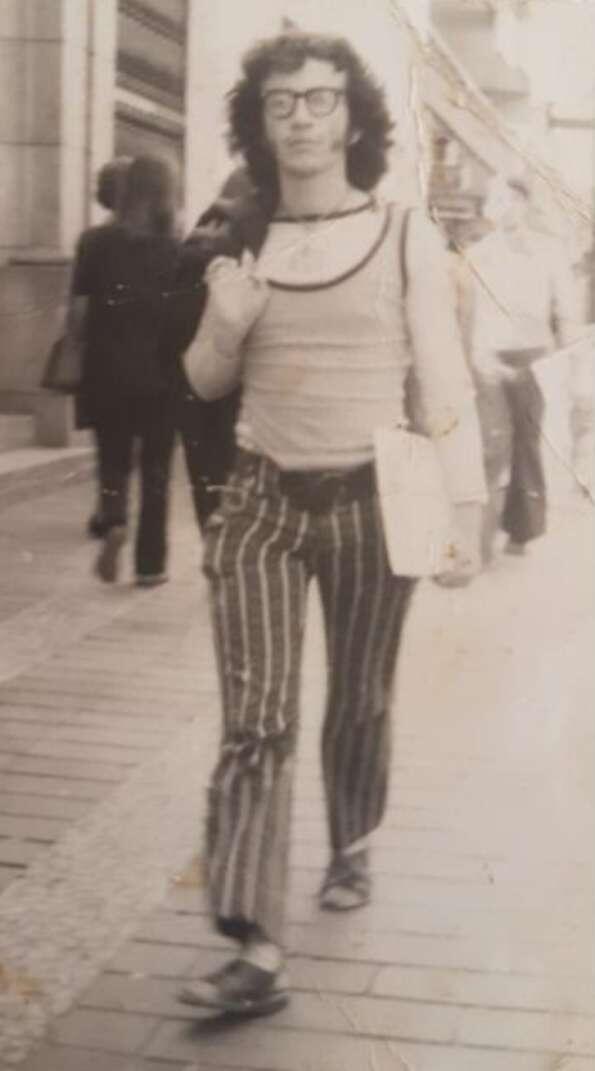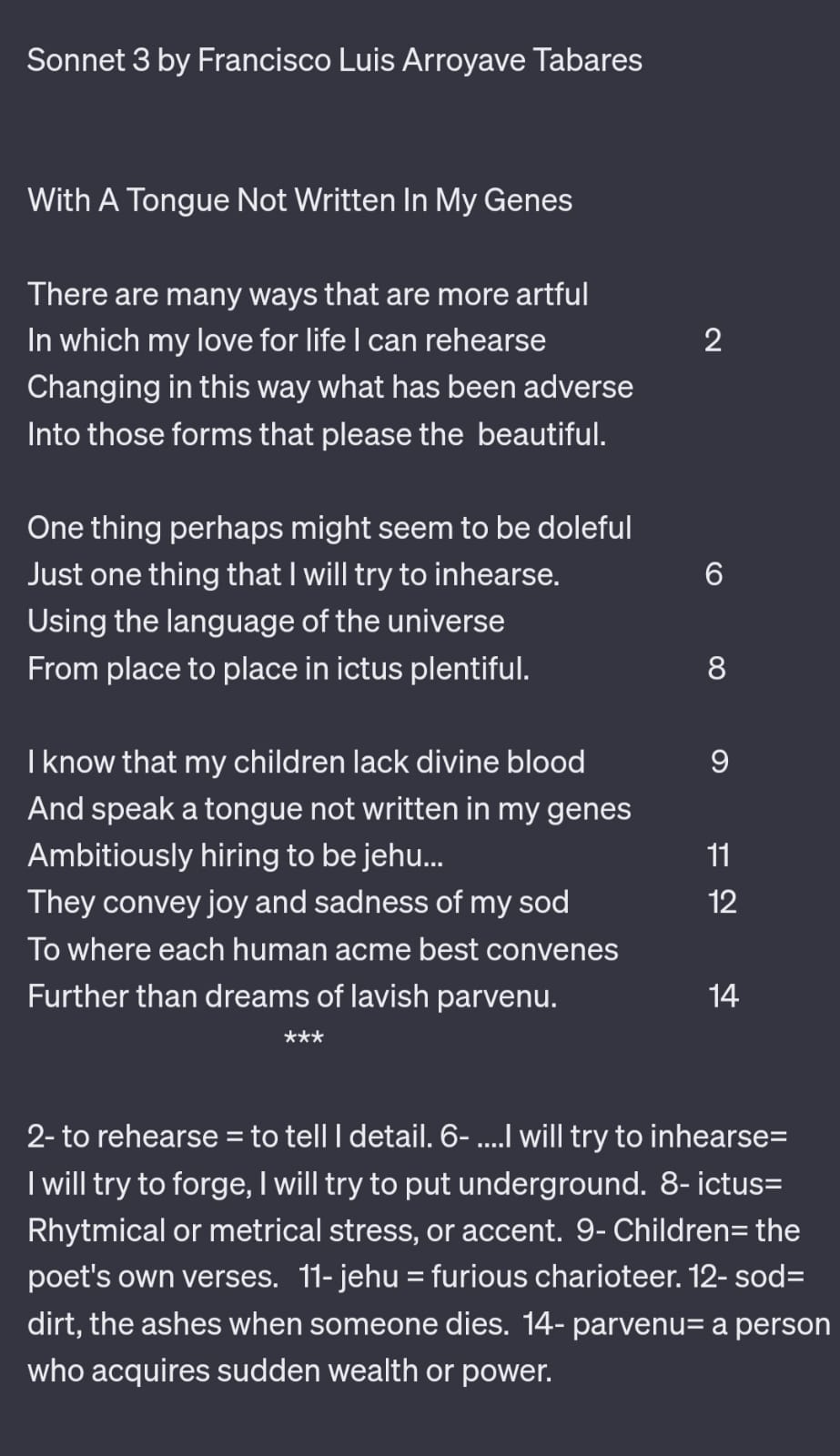-
 @ Francisco Luis
2023-12-02 14:52:42
@ Francisco Luis
2023-12-02 14:52:42Posthumous work of the Colombian poet born in Don Matias on January 20, 1948.
Welcome to this blog dedicated to the Posthumous work of the Colombian poet Francisco Luis Arroyave Tabares (my father), born in Don Matias on January 20, 1948-2010. Where I will be publishing each of the 175 sonnets from his unpublished collection 'Sonnets For The Twenty-First Century And A Circadian Musical (1984-1987).' Analyzed with GPT4 artificial intelligence and illustrated with AI tools... I hope you enjoy this garden of words snatched from the solitude of a locked room.
Likewise, any enthusiast of the sonnet form is invited to conduct their personal studies of Arroyave Tabares' work, as it is a collection that, although registered since 1989, has not yet been published.
Frank Duna

Analysis "With A Tongue Not Written In My Genes"
Introduction
"Sonnet 3" by Francisco Luis Arroyave Tabares is a contemplative piece that explores the poet's relationship with language, his creative process, and his legacy.
Thematic Analysis
In the octave (lines 1-8), the poet discusses his desire to express his love for life in a more artful manner, transforming adversity into beauty. He mentions one sorrowful aspect, which is his attempt to use the universal language, presumably referring to the language of poetry or art. The octave ends with the mention of “ictus,” a term used in poetry to denote rhythmical or metrical stress, suggesting the poet’s struggle with the constraints of poetic form.
The sestet (lines 9-14) shifts the focus to the poet’s “children,” which are metaphorically his verses. These verses lack “divine blood” and speak a language not inherent to the poet’s genes, indicating a struggle between the poet’s ambition and his inherent abilities. The verses carry the joy and sadness of the poet’s life (sod) to the pinnacle of human achievement, beyond the dreams of a parvenu, a person who has suddenly acquired wealth or power. This suggests the poet’s hope that his work will transcend his own limitations and reach a wider audience.
Overall, the sonnet explores themes of artistic struggle, ambition, and the desire for transcendence. The octave sets up the problem, and the sestet provides a resolution, following the classic sonnet structure. The poet’s use of complex metaphors and symbolic language adds depth to these themes.
Structure and Rhyme Scheme
The sonnet follows the traditional Italian (Petrarchan) sonnet rhyme scheme in the octave, but deviates in the sestet.
The octave (lines 1-8) follows the rhyme scheme ABBA ABBA:
A: artful (1) B: rehearse (2) B: adverse (3) A: beautiful (4) A: doleful (5) B: inhearse (6) B: universe (7) A: plentiful (8)The sestet (lines 9-14), however, does not follow the traditional Italian sonnet rhyme scheme (either CDECDE or CDCDCD). Instead, it has a unique rhyme scheme of its own: CDE CDE:
C: blood (9) D: genes (10) E: jehu (11) C: sod (12) D: convenes (13) E: parvenu (14)This deviation in the sestet’s rhyme scheme could be seen as a reflection of the poet’s struggle with the constraints of poetic form, as mentioned in the octave. The poet is trying to express his unique voice within the traditional structure of the sonnet, just as he is trying to express his love for life in a more artful manner. This struggle and ambition are reflected in the unique rhyme scheme of the sestet.
Analysis of Aspects
The sonnet by Francisco Luis Arroyave Tabares is rich in language, imagery, themes, and meter.
Language and Imagery: The poet uses complex metaphors and symbolic language to convey his thoughts and emotions. For instance, the “children” are a metaphor for the poet’s verses, and the “language of the universe” could be interpreted as the language of poetry or art. The imagery of the “ictus,” or rhythmic stress, suggests the poet’s struggle with the constraints of poetic form.
Themes: The sonnet explores themes of artistic struggle, ambition, and the desire for transcendence. The poet expresses his love for life and his ambition to transform adversity into beauty. He also discusses his struggle to express his unique voice within the traditional structure of the sonnet, and his hope that his work will transcend his own limitations and reach a wider audience.
Meter: The sonnet follows the traditional meter of a Petrarchan sonnet, which is typically written in iambic pentameter. This means each line consists of five pairs of unstressed and stressed syllables, creating a rhythmic pattern. However, the poet deviates from this structure in the sestet, reflecting his struggle with the constraints of poetic form.
Overall, The sonnet is a complex and thought-provoking piece of poetry. It effectively uses language, imagery, themes, and meter to convey the poet’s inner thoughts and emotions. The poet’s struggle with the constraints of poetic form and his ambition to transcend these limitations are particularly striking, making the sonnet a compelling exploration of the artistic process.
(GPT4)
Syllable count for each line.
```
With A Tongue Not Written In My Genes
10 There are many ways that are more artful 10 In which my love for life I can rehearse 10 Changing in this way what has been adverse 10 Into those forms that please the beautiful.
10 One thing perhaps might seem to be doleful 10 Just one thing that I will try to inhearse 10 Using the language of the universe 10 From place to place in ictus plentiful.
10 I know that my children lack divine blood 10 And speak a tongue not written in my genes 10 Ambitiously hiring to be jehu... 10 They convey joy and sadness of my sod 10 To where each human acme best convenes 10 Further than dreams of lavish parvenu. ***
```
Sonnets For The Twenty First Century And A Circadian Musical Written By Francisco Luis Arroyave Tabares (1984-1987)
Analyzed by GPT4; Image by leonardo.ai; First published on Nostr Protocol by franciscoarroyavet@nostrplebs.com
 With A Tongue Not Written In My Genes
With A Tongue Not Written In My Genes